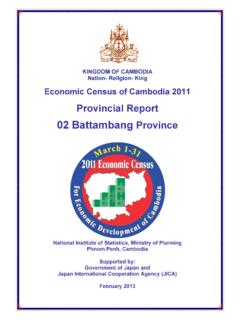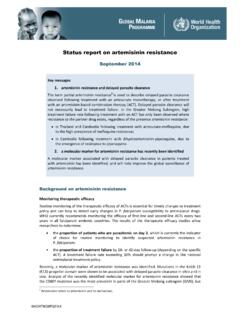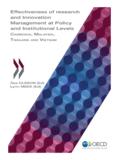Transcription of Arsenic in Cambodia - Home page | UNICEF
1 Arsenic in Cambodia Table of Contents 1. Country Background .. 2. Arsenic Situation and Mitigation Activities .. Discovery of Arsenic in Cambodia .. Areas Affected .. Population Affected .. Incidence of Arsenicosis .. Government s Response .. Arsenic Inter-ministerial Sub Committee .. Water Quality Standard .. Testing and marking of wells .. Database Management .. Information, Education and Communication (IEC) .. Baseline Survey and Clinical Examination of Arsenicosis among exposed population in Kien Svay district, Kandal province.
2 Detection , Confirmation and Management of Arsenicosis in Preak Russie village, Koah Thom district, Kandal provine .. Training and development of technical guidelines on the detection and management supported by WHO Provision of Alternative Water Sources .. Strategic Action Plan .. National Policy Program .. Capacity Building to Staff .. List of Tables Table 1 : Population with suspected srsenicosis symptoms .. 8 Table 2 : Priority parameters in small water supplies facility.
3 10 Table 3 : Families/population using tube wells in the At Risk Areas .. 14 List of Figures Figure 1 : Arsenic risk map in Cambodia .. 7 Figure 2 : Arsenicosis symptoms identified in Kandal Province in 2006 .. 8 Figure 3 : Status of Arsenic contamination in the At Risk Areas .. 13 Figure 4 : Result of testing in At Risk Areas .. 13 Figure 5 : Arsenic contamination by public and private wells .. 14 Figure 6 : Distribution of Arsenic level in At Risk Areas .. 15 Figure 7 : Result of Arsenic testing in school and health centre .. 16 Figure 8 : Map of Arsenic distribution in the At Risk Areas.
4 17 Figure 9 : Arsenic versus well age .. 18 Figure 10 : Well depth versus frequency of Arsenic contamination .. 19 Figure 11 : Result of KAP survey .. 22 Figure 1 : Status of families using Arsenic safe water .. 29 List of Abbreviations AISC : Arsenic Inter-ministerial Sub Committee CNMC : Cambodia National Mekong Commission CSI : Cooperative Services International CWP : Ceramic Water Purifiers DRHC : Department of Rural Health Care DRWS : Department of Rural Water Supply GPS : Global Positioning System IDE : International Development Enterprise IEC : Information Education and Communication ITC : Institute of Technology Cambodia JMP : Joint Monitoring Programme MAFF.
5 Ministry of Agriculture, Forestry and Fisheries MEF : Ministry of Economics and Finance MIME : Ministry of Industry, Mines and Energy MoE : Ministry of Environment MoH : Ministry of Health MOI : Ministry of Interior MOP : Ministry of Planning MOWRAM : Ministry of Water Resources and Meteorology MPWT : Ministry of Public Works and Transport MRD : Ministry of Rural Development NDWQS : National Drinking Water Quality Standard PDRD : Provincial Department of Rural Development PFD : Partners For Development PoE : Provincial Office of Education PPWSA : Phnom Penh Water Authority RDI : Resource Development International SDP : Strategic Development Plan SEILA : A Khmer language word approximating to foundation stone Purpose of this document This document aims to present an overall picture of Arsenic situation in Cambodia and various efforts that have been undertaken to address this issue.
6 Detail information about Arsenic in Cambodia can be found in different documents, which are available in Arsenic center as well as Arsenic website , listed in table. No Type of Document Year 1 A nation-wide rapid assessment of Drinking Water Quality conducted jointly by the Ministry of Rural Development (MRD) and the Ministry of Industry, Mines and Energy (MIME). 2001 2 National Drinking Water Quality Standard 2003 3 Baseline Survey and Clinical Examination of Arsenicosis among Exposed Population in Kien Svay District, Kandal Province.
7 2003 4 Situation Analysis: Arsenic Contamination of Groundwater in Cambodia 2004-2006 5 IEC document and material (school song, video, T-shirt, School lesson plan, poster, leaflet and booklet ) 6 Arsenic Database 7 KAP Survey Report 2006 8 Detection , Confirmation and Management of Arsenicosis in Cambodia 2006 9 Strategic Action Plan 2006 10 Informed Choice Manual for promotion of Arsenic safe water 2007 Cambodia lies in continental Southeast Asia, between the latitudes and North.
8 Geographically the country is mainly flat in the central area and is bordered by Thailand and Laos to the West and North by Vietnam on the East and South, and the Gulf of Thailand on the Southwest. It covers an area of 181,035 Km2 with a total population of million of which 8% live in the Phnom Penh city, 10 % in other urban areas, and the remaining 82% in rural areas. Administratively the country divided into 20 provinces and 4 municipalities. Cambodia is dominated by the two great lakes of the Tonle Sap Lake and the Mekong River.
9 The Tonle Sap covers an area of about 2,600 km2 in the dry season, and over 13,000 km2 in the rainy season. The Mekong River flows southward through the country from the border of Laos, and westward through Phnom Penh to join the Tonle Sap River. The Mekong and Bassac River flow southward from Phnom Penh to the border of Vietnam, passing the Mekong Delta on its way to the South China Sea. The Tonl Sap Lake provides a huge source of fresh water. During the late wet season the Mekong River backs up northwards into the lake increasing the volume of the lake tenfold at the height of the flooding.
10 As the flooding abates, the flow reverses and the level of the lake drops leaving the surrounding area as marshland unsuitable for agriculture, and resulting in a gradual silting up of the lake. The climate is monsoonal with distinct wet and dry seasons of relatively equal length. The southwest monsoon brings the rainy season from mid-May to mid-September, and the northeast monsoon flow of drier, cooler air lasts from early November to March. The total annual rainfall average is between 1000 and 1500 mm, but the amount varies considerably from year to year.
















